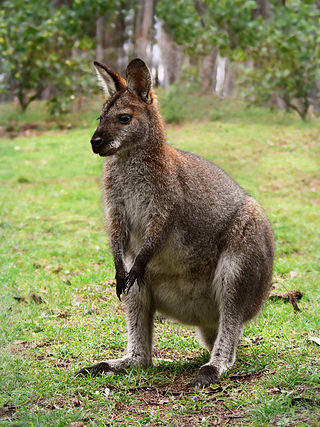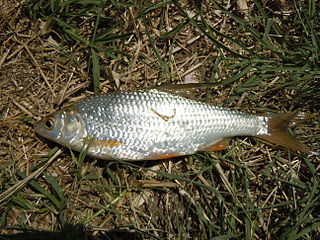
A wallaby is a small or middle-sized macropod native to Australia and New Guinea, with introduced populations in New Zealand, Hawaii, the United Kingdom and other countries. They belong to the same taxonomic family as kangaroos and sometimes the same genus, but kangaroos are specifically categorised into the four largest species of the family. The term "wallaby" is an informal designation generally used for any macropod that is smaller than a kangaroo or a wallaroo that has not been designated otherwise.

Garter snake is the common name for small to medium-sized snakes belonging to the genus Thamnophis in the family Colubridae. They are native to North and Central America, ranging from central Canada in the north to Costa Rica in the south.

Rutilus is a genus of fish in the family Cyprinidae found in Eurasia. This genus is a widely distributed lineage of cyprinids and ranges from West Europe to East Siberia.

Gymnures, also called hairy hedgehogs or moonrats, are mammals belonging to the subfamily Galericinae, in the family Erinaceidae and the order Eulipotyphla. Gymnures resemble rats but are not closely related as they are not rodents; they are instead closely related to hedgehogs, which also belong to Erinaceidae. They are thought to have appeared in Eastern Asia before their closest relatives, and changed little from the original ancestor, which is thought to have been also the ancestor of the shrews.

Castanopsis, commonly called chinquapin or chinkapin, is a genus of evergreen trees belonging to the beech family, Fagaceae. The genus contains about 140 species, which are today restricted to tropical and subtropical eastern Asia. A total of 58 species are native to China, with 30 endemic; the other species occur further south, through Indochina to Indonesia and the Philippines, mountainous areas of Taiwan, and also in Japan. The English name chinkapin is shared with other related plants, including the golden chinkapins of the Pacific United States, which are sometimes included within Castanopsis but are more often considered a separate but very closely related genus, Chrysolepis.

The shrew moles or shrew-like moles (Uropsilus) are shrew-like members of the mole family of mammals endemic to the forested, high-alpine region bordering China, Myanmar, and Vietnam. They possess a long snout, a long slender tail, external ears, and small forefeet unspecialized for burrowing. Although they are similar to shrews in size, external appearance, and, presumably, ecological habits, they are nevertheless talpids and considered true moles, as they share a full zygomatic arch with all other moles, while this arch is completely absent in shrews.

The genus Eligmodontia consists of five or six species of South American sigmodontine mice restricted to Bolivia, Chile, and Argentina. Species of Eligmodontia occur along the eastern side of the Andes Mountains, in Patagonia, and in the Chaco thorn forest of South America. They can be found in arid and semiarid habitats and in both high and low elevation areas. These rodents are commonly known as gerbil mice or by their local name lauchas. Sometimes they are also called silky desert mice, highland desert mice or silky-footed mice. The closest living relatives are probably the chaco mice (Andalgalomys), the leaf-eared mice, and Salinomys.
Cerradomys marinhus, also known as Marinho's rice rat, is a rodent species from South America. It is found in Minas Gerais, Brazil. It was formerly known as Oryzomys marinhus, but was transferred to the new genus Cerradomys in 2006.
Cerradomys subflavus, also known as the terraced rice rat or flavescent oryzomys, is a rodent species from South America in the genus Cerradomys. It is found in the states of Goiás, São Paulo, and Minas Gerais, Brazil. Populations in Bolivia, Paraguay, and elsewhere in Brazil that were previously placed in this species are now classified as various other species of Cerradomys.

Phalanger is a genus of possums. Its members are found on New Guinea, the Maluku Islands, other nearby small islands, and Australia's Cape York Peninsula. They are marsupials of the family Phalangeridae, and are one of the four genera whose species are commonly referred to as cuscuses.

Cerradomys is a genus of oryzomyine rodents from eastern Bolivia, Paraguay, and central Brazil found in cerrado, Caatinga and Gran Chaco habitats.
Oligoryzomys rupestris is a species of rodent in the genus Oligoryzomys of family Cricetidae. It is known only from eastern Brazil, where it has been found in several localities in the campos rupestres montane savanna ecoregion. This is a small Oligoryzomys species with a gray head, a yellow-brown back and gray belly and tail. Of the two karyotypic forms described by Silva & Yonenaga-Yassuda in 1998, species 1 is probably identical to O. rupestris, while the other is closely related. Its karyotype has 2n = 46 and FNa = 52.
Cerradomys langguthi is a species of rodent from South America in the genus Cerradomys. It occurs only in northeastern Brazil and was formerly included in C. subflavus.
Cerradomys vivoi is a species of rodent from South America in the genus Cerradomys. It occurs only in eastern Brazil, in the states of Bahia, Goiás, and Sergipe, and was formerly included in C. subflavus.
Tzaganosuchus is an extinct monospecific genus of fossil crocodile from the Gobi Desert of southern/southeastern Mongolia. The type and only known species for this genus, Tzaganosuchus infansis was discovered during a joint paleontological expedition conducted by the Soviet Union and Mongolia. That same expedition also described several other reptiles including several species of Shamosuchus and the archosauromorph genus Irenosaurus. The prefix of the name "Tzaganosuchus" is a Mongol word derived from the locality where its fossils were first found: the Tsagan Khushu Quarry, which dates to the Paleogene epoch and is part of the Naran-Bulak Formation. The suffix suchus is a Latin word for crocodile.
Qantas is a genus of trematosauroid temnospondyl from the Early Triassic. Fossils have been found from the Kamennyi Yar Formation in Borsky District, Samara Oblast. The type species Qantas samarensis was named in 2012 and placed in the family Benthosuchidae, as it was viewed as a close relative of Benthosuchus. The subfamily Qantasinae was established to include Qantas, and possibly the genus Tirraturhinus. Qantas is named after the Australian airline Qantas, which supported the original study of the fossils.
Sludica is an extinct genus of procynosuchid cynodont from the Late Permian of Russia. Fossils have been found in the Ilinskoe Assemblage Zone within Velikoustyugsky District in Vologda Oblast, correlated with the Cistecephalus Assemblage Zone. The type and only species is Sludica bulanovi.
Coelodontognathus is an extinct genus of reptile from the Early Triassic of European Russia. It was originally described as a procolophonid parareptile in 1967 but was reclassified as a possible trilophosaurid archosauromorph in 2008. The genus includes two species: the type species C. donensis and C. ricovi. C. donensis is known from the holotype PIN 4173/129 and the referred PIN 4173/130, and C. ricovi is known from the holotype PIN 4173/127 and the referred PIN 4173/128, all of which represent dentaries that are housed at the Paleontological Institute, Russian Academy of Sciences. Another dentary, SGU 104/3105, originally referred to C. donensis was reassigned to its own genus and species Vitalia grata by Ivakhnenko, 1973. The fossils have been found at the Donskaya Luka Locality near the village of Sirotinskaya and the Don River in Ilovlinsky District, Volgograd Oblast, from the Lipovskaya Formation of the Gamskii Horizon. Like Coelodontognathus, Vitalia which is known from the same locality was also first identified as a procolophonid and later reclassified as a trilophosaurid. Coelodontognathus and Vitalia are similar to procolophonids in that they have wide teeth but differs from them in that they have tooth roots set deep into the jaws.

Rutilus heckelii is a species of roach, a genus in the family Cyprinidae. This species occurs in freshened areas of Black and Azov Seas, entering the Don, Kuban, Dnipro, Dnister and rarely Danube drainages.
Vitalia is an extinct genus of reptile from the Early Triassic of European Russia known from the type species V. grata. It is known from the holotype dentary PIN 4173/126 as well as two additional dentaries PIN 1043/627 and 1043/628, all housed at the Paleontological Institute, Russian Academy of Sciences. The type dentary was originally included in the hypodigm of Coelodontognathus donensis named by the notable Russian vertebrate paleontologist Vitaliy Georgiyevich Ochev in 1967. Ivakhnenko (1973) separated the specimen and gave it its own genus and species name in light of the new material, which he named in honor of Ochev. The dentaries of Vitalia were collected at the Donskaya Luka Locality near the village of Sirotinskaya in Ilovlinsky District, Volgograd Oblast, from the Lipovskaya Formation of the Gamskii Horizon. Like Coelodontognathus, Vitalia was originally described as a procolophonid parareptile in 1973, but Arkhangelskii & Sennikov (2008) reclassified the taxon as a possible trilophosaurid archosauromorph. Vitalia is thought to be similar to the possible trilophosaurids Coelodontognathus and Doniceps, both of which are known exclusively from the same locality. Coelodontognathus and Vitalia are similar to procolophonids in that they have wide teeth but differs from them in that they have tooth roots set deep into the jaws.










